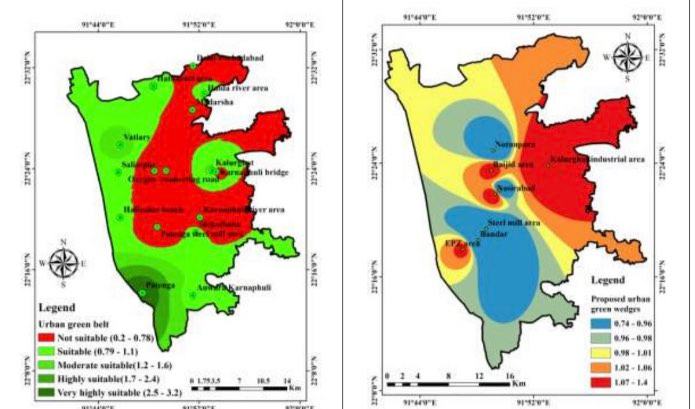Suitability of Urban Green Belt and Green Wedges in Chittagong City, Bangladesh: An Investigation into the Sustainable Urban Environment
DOI:
https://doi.org/10.56261/built.v19.246502Keywords:
Urban green belt; green wedges; suitability analysis; CDA; sustainable urban environment.Abstract
Green belts and green wedges promote ecological balancing and hazard reduction in urban areas. The study attempted to identify suitable locations for urban green belts and green wedges in Chittagong city (CC). The mechanisms of the study were reviewing CC Master Plan, Detailed Area Plan (DAP), field observation, key informant interviews, and small groups discussions. Normalized Difference Vegetation Index was used for the vegetation classification from 1990 to 2021 at a 10-year interval. The urban built-up area of the Chittagong Development Authority (CDA) was 18.64 sq. km in 1990 while it became 139.74 in 2021. In 1990, dense vegetation was 153.21 Sq.km but it decreased to 19.39 Sq.km in 2021, because of rapid population growth and unplanned urbanization. A highly suitable site for the green belt was found in CDA coastal area. Besides, Kalurghat industrial zone, Chittagong Export Processing Zone, Nasirabad, and Baijid area were found appropriate for urban green wedges. Most suitable (83.60 sq. km) and moderately suitable (232.6032 sq. km) areas for the urban green belt were identified and in the coastal zone maximum suitable areas’ length was 57.61 km. The study concluded by urging for land-use zoning and the implementation of the urban green belt and green wedges, and raising voices against hill cutting by urban neighbourhood communities in CC.
Downloads
References
Aguado, I., Barrutia, J. M., & Echebarria, C. (2013). The green belt of Vitoria-Gasteiz. A successful practice for sustainable urban planning. Boletín de la Asociación de Geógrafos españoles.
Amati, M. (Ed.). (2016). Urban green belts in the twenty-first century. Routledge.
Bartier, P. M., & Keller, C. P. (1996). Multivariate interpolation to incorporate thematic surface data using inverse distance weighting (IDW). Computers & Geosciences, 22(7), 795-799.
Chakre, O. J. (2006). Choice of eco-friendly trees in urban environment to mitigate airborne particulate pollution. Journal of human ecology, 20(2), 135-138.
Chen, F. W., & Liu, C. W. (2012). Estimation of the spatial rainfall distribution using inverse distance weighting (IDW) in the middle of Taiwan. Paddy and Water Environment, 10(3), 209-222.
De Oliveira, F. L. (2017). Green wedge urbanism: history, theory and contemporary practice. Bloomsbury Publishing.
Dockerill, B., & Sturzaker, J. (2019). Green belts and urban containment: the Merseyside experience. Planning Perspectives.
Erickson, D. L. (2004). The relationship of historic city form and contemporary greenway implementation: a comparison of Milwaukee, Wisconsin (USA) and Ottawa, Ontario (Canada). Landscape and Urban Planning, 68(2-3), 199-221.
Gant, R. L., Robinson, G. M., & Fazal, S. (2011). Land-use change in the ‘edgelands’: Policies and pressures in London's rural–urban fringe. Land use policy, 28(1), 266-279.
GURL, E. (2017). SWOT analysis: A theoretical review.
Haq, S. M. A. (2011). Urban green spaces and an integrative approach to sustainable environment. Journal of environmental protection, 2(5), 601-608.
Horaginamani, S. M., Ravichandran, M., & Kamdod, A. S. M. (2012). Air pollution tolerance of selectedplant species considered for urban green belt development in Trichy. World Journal of Environmental Biosciences, 1(1), 51-54.
Leigh, D. (2009). SWOT Analysis Handbook of Improving Performance in the Workplace.
Li, F., Wang, R., Paulussen, J., & Liu, X. (2005). Comprehensive concept planning of urban greening based on ecological principles: a case study in Beijing, China. Landscape and urban planning, 72(4), 325-336.
Line, D. G. (1996). The Boise River Greenbelt: perceived benefits and problems associated with the pathway as a place for activity.
Mace, A., Blanc, F., Gordon, I. R., & Scanlon, K. (2016). A 21st century metropolitan green belt.
Mia, M. A., Nasrin, S., Zhang, M., & Rasiah, R. (2015). Chittagong, Bangladesh. Cities, 48, 31-41.
Richert, E. D., & Lapping, M. B. (1998). Ebenezer Howard and the garden city. Journal of the American Planning Association, 64(2), 125-127.
RAJUK (2019) accessed 1 February 2022 retrieved from http://www.rajuk.gov.bd/site/page/68c8d4af-f493-43de-a54c-b0dc83d56bff/
Ramesh, R. M., & Nijagunappa, R. (2014). Development of urban green belts-a super future for ecological balance, Gulbarga city, Karnataka. International Letters of Natural Sciences, 22.
Tan, K. W. (2006). A greenway network for Singapore. Landscape and urban planning, 76(1-4), 45-66.
Teoli, D., Sanvictores, T., & An, J. (2019). SWOT analysis.
Interventions, W. U. G. S. (2017). Health—A Review of Impacts and Effectiveness. World Health Organization.
Xie, X., Kang, H., Behnisch, M., Baildon, M., & Krüger, T. (2020). To what extent can the green belts prevent urban sprawl?—a comparative study of Frankfurt am Main, London and Seoul. Sustainability, 12(2), 679.

Downloads
Published
How to Cite
Issue
Section
License
Copyright (c) 2022 International Journal of Building, Urban, Interior and Landscape Technology (BUILT)

This work is licensed under a Creative Commons Attribution-NonCommercial-NoDerivatives 4.0 International License.











